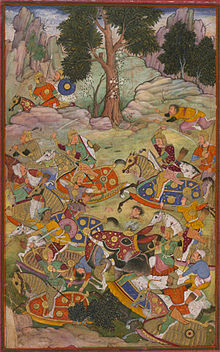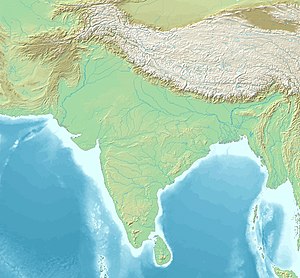A request that this article title be changed to First battle of Panipat is under discussion. Please do not move this article until the discussion is closed. |
| First Battle of Panipat | |||||||||
|---|---|---|---|---|---|---|---|---|---|
| Part of Mughal conquests | |||||||||
 The battle of Panipat and the death of Sultan Ibrāhīm | |||||||||
| |||||||||
| Belligerents | |||||||||
|
|
| ||||||||
| Commanders and leaders | |||||||||
|
Babur Muhammad Khwaja Humayun Mir Khalifa Chin Timur Khan Ustad Ali Quli Mustafa Rumi Asad Malik Hast Raja Ali Khan | Khawas Khan Arghushal Swati (Chief Amir) | ||||||||
| Strength | |||||||||
|
12,000[1] soldiers [2][3] 15–20 field guns[1] |
20,000 regular cavalry[3] 20,000 irregular cavalry[3] 30,000 infantry armed with swords, pikes, bows and bamboo rods[3][2] 1,000 war elephants [4] | ||||||||
| Casualties and losses | |||||||||
| Unknown |
20,000 killed in battle[5] thousands killed while retreating[5] | ||||||||
Location within South Asia | |||||||||
The First Battle of Panipat, on 21 April 1526[6] was fought between the invading forces of Babur and Ibrahim Lodi of the Lodi dynasty. It took place in North India and marked the beginning of the Mughal Empire and the end of the Delhi Sultanate. This was one of the earliest battles involving gunpowder firearms and field artillery in the Indian subcontinent which were introduced by the Mughals in this battle.[7]
Babur defeated the Sultan of Delhi, Ibrahim Lodi, using a combination of tactics such as the use of firearms and cavalry charges. This battle marked the beginning of Mughal rule in India, and its aftermath had a significant impact on the political and social landscape of the country, establishing the Mughal Empire, which lasted for 170 Years(1526-1710).[8]
- ^ a b Watts 2011, p. 707.
- ^ a b Chandra 2009, p. 30.
- ^ a b c d Jadunath Sarkar, Military history of India, p. 50.
- ^ "Battles of Panipat | Summary | Britannica".
- ^ a b Jadunath Sarkar, Military history of India, p. 52.
- ^ Zahir-ud-din Muhammad Babur (2023). بابرنامه (Baburnama) [Original Chagatai Turkic]. The Baburnama Project.
- ^ Butalia 1998, p. 16.
- ^ Bates, Crispin (26 March 2013). Mutiny at the Margins: New Perspectives on the Indian Uprising of 1857: Volume I: Anticipations and Experiences in the Locality. SAGE Publications India. pp. 3–4. ISBN 978-81-321-1336-2.

